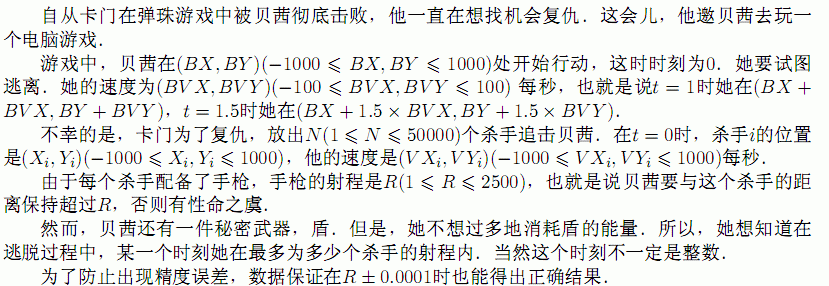Description

Input
第1行输入N,R,BX,BY, BVX,BVY,之后N行每行输入四个整数Xi,Yi,VXi,VYi.
Output
一个整数,表示在逃脱过程中,某一个时刻最多有这个数理的杀手可以射杀贝茜.
Sample Input
3 1 0 0 0 2
0 -3 0 4
1 2 -1 1
1 -2 2 -1
0 -3 0 4
1 2 -1 1
1 -2 2 -1
Sample Output
2
OUTPUT DETAILS:
At time 1.5, Bessie is at point (0, 3), and the three bruisers are
at points (0, 3), (-0.5, 3.5), and (4, -3.5). The first two cattle
bruisers are within 1 unit of Bessie, while the third will never
be within 1 unit of Bessie, so 2 is the most achievable.
OUTPUT DETAILS:
At time 1.5, Bessie is at point (0, 3), and the three bruisers are
at points (0, 3), (-0.5, 3.5), and (4, -3.5). The first two cattle
bruisers are within 1 unit of Bessie, while the third will never
be within 1 unit of Bessie, so 2 is the most achievable.
思路: 我们可以计算出每个杀手可以射击的一个时间范围,然后做扫描线。时间复杂度$O(nlogn)$


1 #include<bits/stdc++.h> 2 using namespace std; 3 int const N = 50000 + 3; 4 double const eps = 1e-8; 5 int n, r, m, in[N], out[N], cnt; 6 double bx, by, bvx, bvy, x[N], y[N], vx[N], vy[N], t1[N], t2[N], t[N << 2]; 7 void calc(int k) { 8 double tx = x[k] - bx; 9 double ty = y[k] - by; 10 double v1 = vx[k] - bvx; 11 double v2 = vy[k] - bvy; 12 double a = v1 * v1 + v2 * v2; 13 double b = 2 * v1 * tx + 2 * v2 * ty; 14 double c = tx * tx + ty * ty - 1.0*r * r; 15 double d = b * b - 4 * a * c; 16 if(fabs(a) < eps ) { 17 if( c<0) { // 这个我始终觉得很奇怪,为什么c小于0就无限解了。 18 m++; 19 t1[m] = 0; 20 t2[m] = 1e10; 21 } 22 return ; 23 } 24 if(d<0) return ; 25 t1[k] = (-b - sqrt(d)) / (2 * a); 26 t2[k] = (-b + sqrt(d)) / (2 * a); 27 if(t2[k] <0) 28 return ; 29 t1[k] = max(0.0, t1[k]); 30 m++; 31 t1[m] = t1[k]; 32 t2[m] = t2[k]; 33 } 34 int main() { 35 scanf("%d%d%lf%lf%lf%lf", &n, &r, &bx, &by, &bvx, &bvy); 36 for(int i = 1; i <= n; i++) { 37 scanf("%lf%lf%lf%lf", &x[i], &y[i], &vx[i], &vy[i]); 38 calc(i); 39 } 40 for(int i = 1; i <= m; i++) { 41 ++cnt; 42 t[cnt] = t1[i]; 43 ++cnt; 44 t[cnt] = t2[i]; 45 } 46 sort(t + 1, t + cnt + 1); 47 int c = unique(t, t + cnt + 1) - t - 1; 48 for(int i = 1; i <= m; i++) { 49 int a = lower_bound(t + 1, t + c + 1, t1[i]) - t; 50 int b = lower_bound(t + 1, t + c + 1, t2[i]) - t; 51 in[a]++; 52 out[b]++; 53 } 54 int ans = 0, now = 0; 55 for(int i = 1; i <= c; i++) { 56 now += in[i]; 57 ans = max(ans, now); 58 now -= out[i]; 59 } 60 printf("%d\n", ans); 61 return 0; 62 }





配置Halcon(一次配置,永久使用))
msys2使用教程)




)



_苹果MAC_操作系统_脚本之家)



